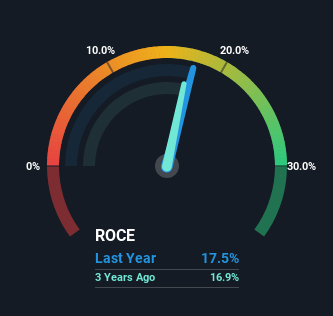Investors Met With Slowing Returns on Capital At Nestlé (VTX:NESN)
If you're looking for a multi-bagger, there's a few things to keep an eye out for. In a perfect world, we'd like to see a company investing more capital into its business and ideally the returns earned from that capital are also increasing. If you see this, it typically means it's a company with a great business model and plenty of profitable reinvestment opportunities. Having said that, from a first glance at Nestlé (VTX:NESN) we aren't jumping out of our chairs at how returns are trending, but let's have a deeper look.
Return On Capital Employed (ROCE): What Is It?
For those that aren't sure what ROCE is, it measures the amount of pre-tax profits a company can generate from the capital employed in its business. The formula for this calculation on Nestlé is:
Return on Capital Employed = Earnings Before Interest and Tax (EBIT) ÷ (Total Assets - Current Liabilities)
0.18 = CHF16b ÷ (CHF127b - CHF37b) (Based on the trailing twelve months to December 2023).
So, Nestlé has an ROCE of 18%. In absolute terms, that's a satisfactory return, but compared to the Food industry average of 13% it's much better.
See our latest analysis for Nestlé
Above you can see how the current ROCE for Nestlé compares to its prior returns on capital, but there's only so much you can tell from the past. If you're interested, you can view the analysts predictions in our free analyst report for Nestlé .
So How Is Nestlé's ROCE Trending?
Over the past five years, Nestlé's ROCE and capital employed have both remained mostly flat. It's not uncommon to see this when looking at a mature and stable business that isn't re-investing its earnings because it has likely passed that phase of the business cycle. With that in mind, unless investment picks up again in the future, we wouldn't expect Nestlé to be a multi-bagger going forward. That being the case, it makes sense that Nestlé has been paying out 62% of its earnings to its shareholders. If the company is in fact lacking growth opportunities, that's one of the viable alternatives for the money.
The Bottom Line
In summary, Nestlé isn't compounding its earnings but is generating stable returns on the same amount of capital employed. And with the stock having returned a mere 8.5% in the last five years to shareholders, you could argue that they're aware of these lackluster trends. So if you're looking for a multi-bagger, the underlying trends indicate you may have better chances elsewhere.
On a separate note, we've found 1 warning sign for Nestlé you'll probably want to know about.
If you want to search for solid companies with great earnings, check out this free list of companies with good balance sheets and impressive returns on equity.
Have feedback on this article? Concerned about the content? Get in touch with us directly. Alternatively, email editorial-team (at) simplywallst.com.
This article by Simply Wall St is general in nature. We provide commentary based on historical data and analyst forecasts only using an unbiased methodology and our articles are not intended to be financial advice. It does not constitute a recommendation to buy or sell any stock, and does not take account of your objectives, or your financial situation. We aim to bring you long-term focused analysis driven by fundamental data. Note that our analysis may not factor in the latest price-sensitive company announcements or qualitative material. Simply Wall St has no position in any stocks mentioned.

 Yahoo Finance
Yahoo Finance 
